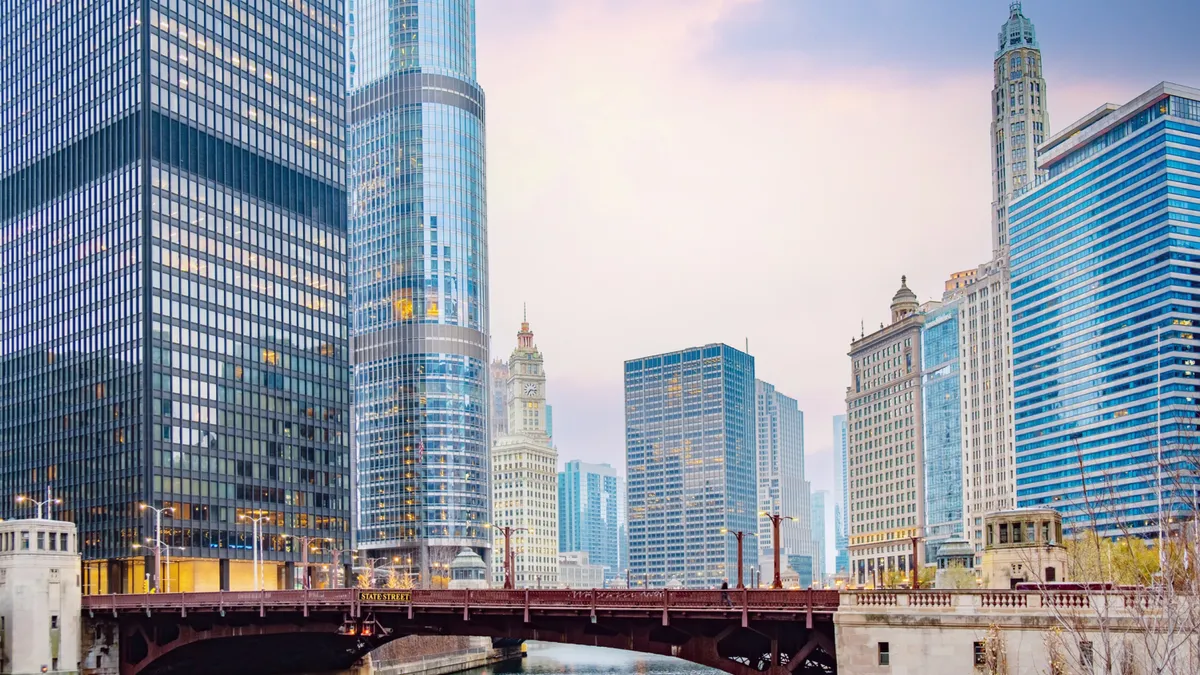Dive Brief:
- Retrofitting, renovating or reusing existing buildings can be more effective in reducing operational and embodied carbon than constructing new ones, Ming Hu, associate dean for research, scholarship and creative work at the University of Notre Dame’s School of Architecture, suggests in a research note Sept. 3
- An analysis of embodied carbon in over 1 million buildings in Chicago led by Hu and Ph.D. student Siavash Ghorbany reveals that increasing the average lifespan of buildings from 50 years to 75 or 80 years and reducing building size by 20% can cut their overall carbon emissions by two-thirds.
- The team is in the process of replicating the methods used in this study to create embodied carbon measures for buildings in Houston, Denver and Washington, D.C., with a goal of developing a picture of embodied carbon across most U.S. metropolitan areas by the end of 2025, Hu said in an interview.
Dive Insight:
In the U.S., a lack of methodology to measure the entire building stock, building-level data at the national scale and benchmarks to assess embodied carbon performance are the three main knowledge gaps in understanding whole-building embodied carbon impacts, the study says. Differences between states’ existing building inventory, climate and market demand, population size and density further complicate these assessments, it says.
The research used machine learning and artificial intelligence to develop an integrated dataset for the analysis, pulling data from existing sources including the National Structure Inventory and Cook County Open Data for Chicago. The study, which provides a visual analysis tool to evaluate embodied carbon at a granular level, identifies 157 different architectural building types, with buildings averaging 1,819 square feet and a mean year built of 1958.
Hu and Ghorbany matched different types of data using geolocation before coding and categorizing buildings based on features such as structural materials and roof type. The team then multiplied the building type’s baseline emissions by the footprint of each building to approximate its total embodied carbon. When analyzed at the city scale, buildings with masonry structures and walls, basement foundations and tar and gravel roofs were found to have the highest lifecycle emissions compared with other archetypes, due largely to rooftop material, the study found.
Buildings with wooden structural elements and walls, basements and shingled roofs, accounting for 29% of the analyzed building stock, were found to have the lowest emission rates, the study says.
Considering a building’s entire lifespan, renovating an existing building has significantly lower carbon emissions over its whole life cycle, including operational and embodied carbon, Hu said. As a result, demolishing an existing building to construct a new one makes little sense from an environmental perspective, even if that new building is more energy efficient, according to the research note.
Retrofitting commercial buildings is not without challenges, however. Hu pointed to a misalignment of incentives, longer payback periods, regulatory hurdles and a lack of awareness and expertise as key deterrents to retrofits. “Owners may hesitate to invest in retrofits when tenants reap the benefits of lower energy bills,” Hu said. “Additionally, some energy-efficient upgrades come with high embodied carbon costs.”
“The coordination of diverse stakeholders, such as owners, tenants, contractors and investors, further complicates retrofit projects, alongside the challenge of integrating new technologies with outdated infrastructure in older buildings, which may require extensive and costly upfront costs,” Hu said.
The type of retrofit or renovation being considered largely depends on the building owner's objectives, though, Hu said. “If the goal is to enhance energy efficiency and achieve long-term cost savings, upgrading the HVAC system and improving the building envelope should be prioritized,” Hu said.
Purely cosmetic upgrades, without any building performance improvements, will inevitably increase embodied carbon, however, Hu said. “Typically, we perform both lifecycle assessment and lifecycle cost assessment to guide building owners in making informed decisions,” Hu said.













